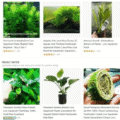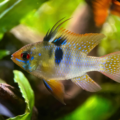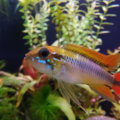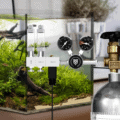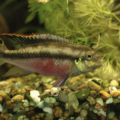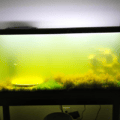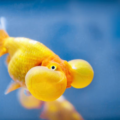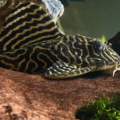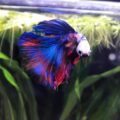This South American Cichlid will transform your aquarium. This is the complete guide on all things Panda Dwarf Cichlid, including diet, breeding, tank setup, and health care.

Every fishkeeper looks for the one water dweller that’ll give their aquarium a unique touch, and I’ve found the right fish for you! Apistogramma nijsseni also called Nijsseni or Panda Dwarf Cichlid.
It has a vibrant two-tone coloration and a fascinating personality that’ll stop you in your tracks. If you’re ready to join the many enthusiasts who keep this beautiful fish in their tanks, then you’ll need the basics of Apistogramma nijsseni care.
Luckily for you, this Panda Dwarf Cichlid overview highlights the best of these South American Cichlids tips to ensure your aquarium is the envy of your peers. So, let’s begin!
See Also: 15 Dwarf Cichlids for a Peaceful Community Aquarium
A Closer Look at Apistogramma nijsseni’s Unique Beauty
The first step in identifying Panda Cichlids is looking at their physical traits. If they share features with other varieties, then you must look at the behavioral patterns. So, let’s start with the obvious.
Body and Size
Mature Panda cichlids grow between 5cm to 7cm, with the males being larger and the females smaller. They have long and round dorsal and caudal fins. Now, let’s take a closer look at this vibrant aquarium fish’s coloration.
Color Pattern
Like with the size, Apistogramma nijsseni males and females have different color patterns.

| Female Panda Cichlid (Top Picture) | Yellow scales with black markings from head to mid-point. |
| Male Panda Cichlid (Bottom Picture) | Blue and Green Iridescent scales with Red, Blue, and Black patterned fins |
Unique Traits
Now, let’s look at the unique Apistogramma traits that separate them from other fish.
Crafting the Ideal Habitat for Apistogramma nijsseni

It is time to build the perfect home for your pets using the right Apistogramma nijsseni tank setup from size to layout, water parameters, substrate, and decor.
Tank Size and Layout
Because this species is average-sized, you’ll need a rectangular tank that holds about 20 gallons of water per pair.
Water Parameters
The ideal habitat for Panda cichlids will have the following parameters:
- Temperature: 75 – 82℉ %
- pH Levels: 5 – 6.5, slightly acidic
- Hardness: 0 – 3 GH, soft water
- Filtration: Low current
Substrate and Decor
Once you’ve set the ideal parameters in the right-sized tank, it’s time to design the layout. The aquarium layout for dwarf cichlids should cater to their unique size and physical features.
| Substrate | Decor |
| Fine sand resembling riverbeds for foraging Dark tones to highlight their black and white scales | Lighting: Low to dim-lighting Hiding Spots: Driftwood, Leaf Litter Shade: Dense Plants Breeding Spots: Caves, Saucers, Large Leaves |
Feeding the Panda Cichlid: A Guide to Optimal Nutrition
Do you already have a background in nutrition for South American cichlids? Then you’re ready to feed your pets, but if you don’t, I’ve got you. Because this species is omnivorous, here are some live foods and plant matter you can add to your plan for feeding Apistogramma nijsseni:
Diet Suggestions
| Staples | Supplements | Treats |
| – High-quality flakes and pellets – Live food like Daphnia, Brine Shrimp, and Worms. | – Brine Shrimps – Bloodworms | – Vegetables like Spinach, Zucchini, and peeled Peas – Fruits like Chopped cucumber slices are fed only once a month. |
For more on feeding your aquatic pets check out The Ultimate Guide to Fish Food: Pros and Cons & Best Choices!
Feeding Tips
Once you’ve prepared your Panda Dwarf cichlid diet, it’s important to follow a feeding regimen for your pets. Give them only meal portions they can finish in 2-3 minutes two to three times daily.
Breeding Apistogramma nijsseni: A Rewarding Challenge
I’m sure you’re ready to read the best Dwarf cichlid spawning tips to help you breed more of these beautiful water dwellers, and the answers are here.
Luckily for you, the setup for breeding Panda cichlids is almost the same as those for their living conditions, so you don’t need to change much.
Breeding Setup
It’s best to create a separate breeding tank or divide your main tank into two. Each breeding pair requires at least 20 gallons of slightly acidic, soft water. Also, ensure there are caves where the females can lay their eggs.
Male Panda cichlids fertilize the eggs externally and protect them until they hatch into fry within 2-3 days.
Fry Care Tips
These specialized Apistogramma nijsseni fry care tips will ensure your pets grow into vibrant, healthy adults.
| Diet | Infusoria, Finely crushed fry flakes, Baby Brine Shrimp |
| Water Quality | Pristine and filtered free of ammonia and nitrites |
Watch your Panda cichlid fry and monitor their growth. Separate the larger and stronger ones from the small, weak fry. Once they’re fully formed and free-swimming, quarantine them for about two weeks before adding the grown Apistogramma nijsseni to the main tank.
Breeding this species is challenging, but it gets easier with constant practice, and you’ll see the rewards sooner rather than later.
However, that’s only one part of the breeding experience. You must also carefully select your Panda cichlid’s tank mates to avoid bullying and predatory behavior.
See Also: 12 Freshwater Fish for a BUSTLING 20-Gallon Tank
Selecting the Best Tank Mates for Apistogramma nijsseni
When selecting compatible species for dwarf cichlids, you must consider species that’ll make for peaceful aquarium fish setups. They must have the same or similar environmental needs, diets, sizq2e, and temperaments to avoid competition and stress.
Check out this table for some examples of the right and wrong tank mates for Panda cichlids.
| Compatible Species | Avoided Species |
| Tetras Dwarf Corydoras Small Rasboras | Larger fish Aggressive fish Smaller species |
Preventing Common Health Issues in Apistogramma nijsseni
Prioritizing Apistogramma nijsseni health care is the only way to ensure your pets live long and healthy lives. You can start by preventing dwarf cichlid disease by adopting healthy aquarium fish tips then build on it by making it a habit.
Here’s a table of common health issues, their symptoms, causes, and treatments.
| Illness | Causes | Symptoms | Treatment |
| Stress | Poor water quality Incompatible tank mates Wrong tank setup | Discoloration Laziness Irritability | Improve water quality Change tank mates Adjust tank setup |
| Fungal Disease | Poor water quality Untreated injuries Stress | Cotton growth on the scales | Improve water quality Treat injuries Use antifungal treatment |
| Parasites | Nematodes Protozoa | Bloating Weight Loss Stringy white feces Weight Loss | Antiparasitic agents |
Check out How to Treat Ich Outbreaks in Your Freshwater Fish for more information on Ich!
Extending the Lifespan of Apistogramma nijsseni
Are you enjoying your pet’s company? Would you like to keep them for the rest of their 4-5 years of life? Then study these lifespan factors and tighten your strategy for long-term aquarium fish care.
Lifespan Factors
You’ll be pleased to learn that following the tips I’ve shared with you so far is all the Apistogramma nijsseni lifespan guide you need. Scroll back up for tips on diet, water quality, and stress-free tank conditions.
Care Tips for Longevity
Maintaining healthy Panda cichlids is the surest way to elongate their lives, and you can do that by creating healthy routines. Always check to ensure the lifespan factors are in optimal condition and fix errors where necessary.
Conclusion
Now, we can tie a bow on our neatly wrapped Apistogramma nijsseni care tips. You know all the essentials, from identifying its striking appearance to noting the Panda cichlid’s unique traits and dietary needs to providing a breeding guide for beginners.
Also, don’t forget that you must replicate its natural habitat and make these freshwater fish care tips a consistent practice for best result. Don’t leave any part out if you want a fulfilling fishkeeping experience.
If you loved this Panda cichlid aquarium guide, check out our other reviews and tips for more fish in your tank.

